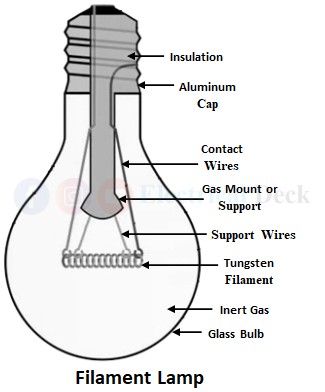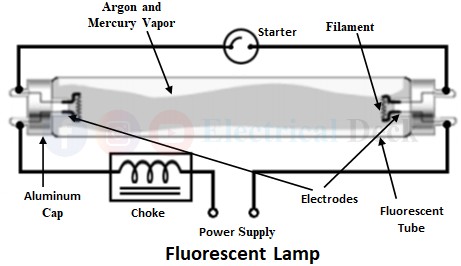The filament and fluorescent lamps are the two different types of most commonly used lamps. The filament lamps work on the phenomenon of incandescent where a high resistance filament is heated until it radiates visible light. Whereas a fluorescent lamp works by ionizing a gas that emits photons. Let us see the difference between a filament and a fluorescent lamp in detail.
Filament Lamp (Incandescent Lamp) :
A filament lamp essentially consists of a fine wire (filament) of high resistance usually made up of tungsten placed in an evacuated glass bulb as shown below. The bulb is filled with argon and nitrogen gas and completely evacuated in order to prevent oxidation so as to minimize loss of heat by convection. The ends of the filament are connected by thick copper leads to the contact points at the top of the bulb.
When the power supply is given to the filament, the temperature of the filament increases to a very high value such that the filament emits heat and light waves. The most commonly used filament materials are carbon, osmium, and tungsten.
Since the light produced is due to filament heating caused by an electric current through it i.e., incandescent phenomenon, this lamp is called Incandescent Lamp. The filament used in this type of lamp must possess a high melting point, ductile, high specific resistance, easily available, and good mechanical strength.
Fluorescent Lamp :
The fluorescent lamps are hot cathode low-pressure mercury vapor lamps that produce visible light through fluorescent. They are manufactured in different lengths and colors in which the working principle remains the same for all.
It consists of a glass tube with two filaments made up of tungsten material in spiral coil form as shown below. The two filaments are coated with electron-emitting material.
The tube is filled with low-pressure mercury vapor and argon gas with an inner surface coated with fluorescent powder. A starter is connected in the circuit that connects two electrodes across the supply at the time of starting and a choke is used for limiting the high current.
When supply is given, current starts flowing through the electrodes. Due to the high resistance of filaments, they get heated up and the temperature increases which in turn results in the ionization of gas inside the tube.
Now the gas starts conducting and an arc is formed between two filaments through the gas. The electrons in the gas start realizing energy (photons at UV frequencies) in form of electromagnetic radiations. This radiation when striking the fluorescent powder, visible light is produced out from the tube.
Difference Between Filament Lamp and Fluorescent Lamp :
| Filament Lamp | Fluorescent Lamp |
|---|---|
| The light is produced by heating the filament caused by an electric current through it i.e., incandescent phenomenon. | The light is produced by ionization of low-pressure mercury vapor, resulting in the emission of photons from gas at UV frequencies after which the UV rays are converted into visible rays with the help of fluorescent powder. |
| It works on ac as well as dc power supply. | Change of supply needs additional accessories. |
| It radiates the light, the color of which resembles natural light. | The light emitted does not resembles natural light. Thus object color cannot be properly judged. |
| Starting of this lamp is instantaneous. | It takes very little time (about 1sec). |
| The stroboscopic effect is absent. | The stroboscopic effect exists. |
| The initial cost is minimum. | The initial cost is moderate. |
| The normal working life of a filament lamp is 1000 hrs. | The normal working life of a fluorescent lamp is 4000-5000 hrs. |
| The operating temperature of the lamp is about 2000°C. | The operating temperature of the lamp is about 50°C. |
| Luminous efficiency is about 8-10 lumen/watt. | Luminous efficiency is about 40 lumen/watt |
| As the lamp operates at a high temperature it emits more heat radiation. | As the working temperature of the lamp is low, it emits less heat radiation. |
| It provides more brightness. | The brightness is low. |
| The luminous output can be increased by increasing the voltage. | The luminous output per watt does not increase with an increase in the voltage. |
| They are mostly used for domestic, industrial, and street lighting. | They find wide applications in domestic, industrial, street, and floodlighting. |
| For obtaining different colors of light, colored glasses are to be used but colored glass reduces the efficiency. | Different colors of lights can be obtained by using fluorescent powder and the efficiency remains the same for all the colors. |


